Do you have a question about the Cisco Nexus 7706 and is the answer not in the manual?
Defines the target audience for the Cisco Nexus 7706 Hardware Installation Guide.
Explains the conventions used in the document for text formatting and command syntax.
Provides instructions on how to submit feedback or report errors in the document.
Guides users on how to obtain Cisco documentation and submit service requests.
Provides a high-level overview of the Cisco Nexus 7706 switch's hardware features and components.
Details the acceptable humidity levels for operating and storing the Cisco Nexus 7706 switch.
Specifies the operating and storage altitude limits for the Cisco Nexus 7706 switch.
Outlines precautions and requirements to minimize dust and particle contamination.
Provides guidelines to reduce EMI and RFI to ensure proper operation.
States the shock and vibration standards the switch meets for installation and handling.
Explains the importance and procedure for grounding the switch for protection.
Guides users on how to determine and plan for the switch's power needs.
Details the specifications for racks and cabinets suitable for installing the switch.
Specifies the necessary clearances around the chassis for installation and airflow.
Provides steps for installing the rack or cabinet before chassis installation.
Details the process for unpacking and verifying the switch components.
Instructions for attaching bottom-support rails to a two-post rack for stability.
Instructions for attaching bottom-support rails to a four-post rack for stability.
Step-by-step guide for installing the chassis into a two-post rack.
Step-by-step guide for installing the chassis into a four-post rack or cabinet.
Explains how to properly ground the switch chassis for safety and protection.
Details the procedure for bonding the front ID door to the chassis ground.
Instructions for installing cable management frames on the chassis.
Steps for attaching the optional front door to the chassis.
Guide for installing optional air filters on the chassis and cable management frames.
Provides best practices for handling and connecting transceivers and optical cables.
Details how to establish a local management connection via a console terminal.
Explains how to connect the switch's management port for network access.
Guides users through the initial setup and configuration of the switch.
Provides instructions for connecting fiber-optic cables to transceivers.
Explains the procedure for safely disconnecting optical cables from transceivers.
Offers maintenance guidelines for transceivers and optical cables.
Shows how to display information about installed hardware using the 'show hardware' command.
Explains how to display FRU information, product IDs, and serial numbers using 'show inventory'.
Details how to display backplane information including serial numbers using 'show sprom backplane'.
Shows how to display environmental information using the 'show environment' command.
Explains how to view module temperature readings using 'show environment temperature'.
Describes how to connect to a module using the 'attach module' command.
Explains how to save module configurations and scenarios where they are preserved or lost.
Shows how to display switch power usage information using 'show environment power'.
Details how to reset a module using the 'reload module' command.
Explains how to reboot or reload the switch using the 'reload' command.
Provides an overview of the switch's supervisor module types and their operation.
Instructions for shutting down a supervisor module using the 'out-of-service module' command.
Lists the I/O modules supported by the Cisco Nexus 7700 Series switches.
Explains how to access an I/O module's console port for troubleshooting.
Shows how to display installed module information using 'show module' commands.
Details how to clear the running configuration for an I/O slot using 'purge module'.
Explains how to shut down or power up an I/O module using 'poweroff module' command.
Describes the fabric modules supported by the switch and their compatibility.
Guides on modifying power reservation for fabric modules to free up unused slots.
Instructions for shutting down or powering up a fabric module.
Explains the different power modes available for switch operations.
Provides guidelines for configuring power redundancy modes based on installed supplies.
Details how to configure the switch's power supply mode.
Explains the critical importance of ESD protection when handling modules.
Step-by-step instructions for installing or replacing supervisor modules.
Guides the process of migrating from Supervisor 2E to Supervisor 3E modules.
Detailed steps for installing or replacing I/O modules in the chassis.
Instructions for replacing a fan tray while the switch is operating.
Procedure for migrating from Gen 1 to Gen 2 fan trays.
Step-by-step guide for installing or replacing fabric modules.
Instructions for replacing Fabric 2 modules with Fabric 3 modules.
Steps to downgrade from Fabric 3 to Fabric 2 modules if issues arise.
Detailed steps for installing or replacing power supply units in the switch chassis.
Guides on connecting 3-kW AC power supplies to AC power sources.
Instructions for connecting 3.5-kW HVAC/HVDC power supplies to AC power sources.
Details on connecting DC power supplies to DC power circuits.
Instructions for connecting 3.5-kW HVAC/HVDC power supplies to DC power sources.
Details environmental parameters like temperature, humidity, and altitude for the switch.
Provides the physical dimensions of the Cisco Nexus 7706 chassis and related components.
Lists the power requirements for supervisor modules of the Cisco Nexus 7706 switch.
Details maximum power availability for 3-kW AC power supplies under various modes.
Details maximum power availability for 3-kW DC power supplies under various modes.
Details maximum power availability for 3.5-kW AC inputs under various modes.
Details maximum power availability for 3.5-kW DC inputs under various modes.
Lists the weights and quantities of chassis, modules, fan trays, and power supplies.
Details transceivers, connectors, and cables for various I/O modules.
Provides specifications for power supply cables, including RJ-45 connectors.
Describes the status and meaning of LEDs on the switch chassis.
Explains the meaning of LEDs for supervisor modules.
Details the status and meaning of LEDs for I/O modules.
Describes the status and meaning of LEDs for fabric modules.
Explains the status and meaning of LEDs for fan trays.
Describes the status and meaning of LEDs for power supply units.
Lists and illustrates the contents of the standard accessory kit.
Details the contents of the center-mount rails kit for two-post rack installations.
Provides a checklist of site planning tasks for successful switch installation.
Worksheet to record essential contact and site information.
Worksheets for recording chassis and module details like serial numbers and IP addresses.
Defines the target audience for the Cisco Nexus 7706 Hardware Installation Guide.
Explains the conventions used in the document for text formatting and command syntax.
Provides instructions on how to submit feedback or report errors in the document.
Guides users on how to obtain Cisco documentation and submit service requests.
Provides a high-level overview of the Cisco Nexus 7706 switch's hardware features and components.
Details the acceptable humidity levels for operating and storing the Cisco Nexus 7706 switch.
Specifies the operating and storage altitude limits for the Cisco Nexus 7706 switch.
Outlines precautions and requirements to minimize dust and particle contamination.
Provides guidelines to reduce EMI and RFI to ensure proper operation.
States the shock and vibration standards the switch meets for installation and handling.
Explains the importance and procedure for grounding the switch for protection.
Guides users on how to determine and plan for the switch's power needs.
Details the specifications for racks and cabinets suitable for installing the switch.
Specifies the necessary clearances around the chassis for installation and airflow.
Provides steps for installing the rack or cabinet before chassis installation.
Details the process for unpacking and verifying the switch components.
Instructions for attaching bottom-support rails to a two-post rack for stability.
Instructions for attaching bottom-support rails to a four-post rack for stability.
Step-by-step guide for installing the chassis into a two-post rack.
Step-by-step guide for installing the chassis into a four-post rack or cabinet.
Explains how to properly ground the switch chassis for safety and protection.
Details the procedure for bonding the front ID door to the chassis ground.
Instructions for installing cable management frames on the chassis.
Steps for attaching the optional front door to the chassis.
Guide for installing optional air filters on the chassis and cable management frames.
Provides best practices for handling and connecting transceivers and optical cables.
Details how to establish a local management connection via a console terminal.
Explains how to connect the switch's management port for network access.
Guides users through the initial setup and configuration of the switch.
Provides instructions for connecting fiber-optic cables to transceivers.
Explains the procedure for safely disconnecting optical cables from transceivers.
Offers maintenance guidelines for transceivers and optical cables.
Shows how to display information about installed hardware using the 'show hardware' command.
Explains how to display FRU information, product IDs, and serial numbers using 'show inventory'.
Details how to display backplane information including serial numbers using 'show sprom backplane'.
Shows how to display environmental information using the 'show environment' command.
Explains how to view module temperature readings using 'show environment temperature'.
Describes how to connect to a module using the 'attach module' command.
Explains how to save module configurations and scenarios where they are preserved or lost.
Shows how to display switch power usage information using 'show environment power'.
Details how to reset a module using the 'reload module' command.
Explains how to reboot or reload the switch using the 'reload' command.
Provides an overview of the switch's supervisor module types and their operation.
Instructions for shutting down a supervisor module using the 'out-of-service module' command.
Lists the I/O modules supported by the Cisco Nexus 7700 Series switches.
Explains how to access an I/O module's console port for troubleshooting.
Shows how to display installed module information using 'show module' commands.
Details how to clear the running configuration for an I/O slot using 'purge module'.
Explains how to shut down or power up an I/O module using 'poweroff module' command.
Describes the fabric modules supported by the switch and their compatibility.
Guides on modifying power reservation for fabric modules to free up unused slots.
Instructions for shutting down or powering up a fabric module.
Explains the different power modes available for switch operations.
Provides guidelines for configuring power redundancy modes based on installed supplies.
Details how to configure the switch's power supply mode.
Explains the critical importance of ESD protection when handling modules.
Step-by-step instructions for installing or replacing supervisor modules.
Guides the process of migrating from Supervisor 2E to Supervisor 3E modules.
Detailed steps for installing or replacing I/O modules in the chassis.
Instructions for replacing a fan tray while the switch is operating.
Procedure for migrating from Gen 1 to Gen 2 fan trays.
Step-by-step guide for installing or replacing fabric modules.
Instructions for replacing Fabric 2 modules with Fabric 3 modules.
Steps to downgrade from Fabric 3 to Fabric 2 modules if issues arise.
Detailed steps for installing or replacing power supply units in the switch chassis.
Guides on connecting 3-kW AC power supplies to AC power sources.
Instructions for connecting 3.5-kW HVAC/HVDC power supplies to AC power sources.
Details on connecting DC power supplies to DC power circuits.
Instructions for connecting 3.5-kW HVAC/HVDC power supplies to DC power sources.
Details environmental parameters like temperature, humidity, and altitude for the switch.
Provides the physical dimensions of the Cisco Nexus 7706 chassis and related components.
Lists the power requirements for supervisor modules of the Cisco Nexus 7706 switch.
Details maximum power availability for 3-kW AC power supplies under various modes.
Details maximum power availability for 3-kW DC power supplies under various modes.
Details maximum power availability for 3.5-kW AC inputs under various modes.
Details maximum power availability for 3.5-kW DC inputs under various modes.
Lists the weights and quantities of chassis, modules, fan trays, and power supplies.
Details transceivers, connectors, and cables for various I/O modules.
Provides specifications for power supply cables, including RJ-45 connectors.
Describes the status and meaning of LEDs on the switch chassis.
Explains the meaning of LEDs for supervisor modules.
Details the status and meaning of LEDs for I/O modules.
Describes the status and meaning of LEDs for fabric modules.
Explains the status and meaning of LEDs for fan trays.
Describes the status and meaning of LEDs for power supply units.
Lists and illustrates the contents of the standard accessory kit.
Details the contents of the center-mount rails kit for two-post rack installations.
Provides a checklist of site planning tasks for successful switch installation.
Worksheet to record essential contact and site information.
Worksheets for recording chassis and module details like serial numbers and IP addresses.
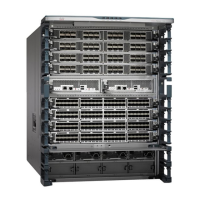
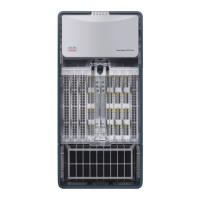


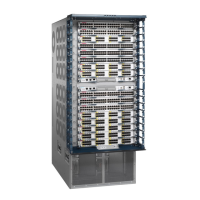
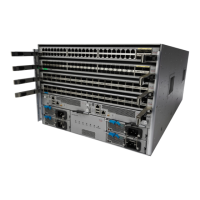
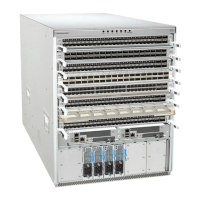

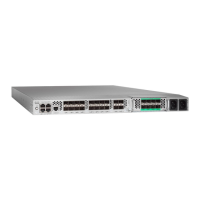
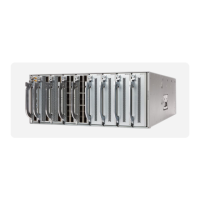
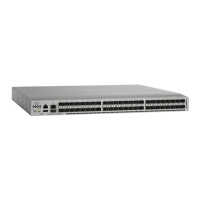
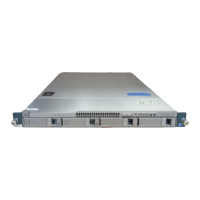
